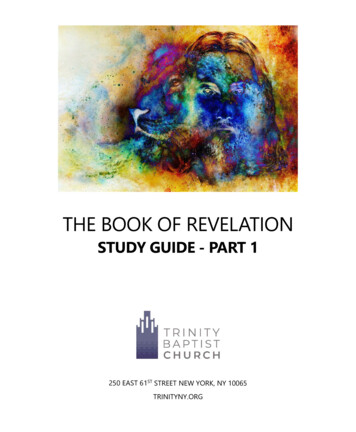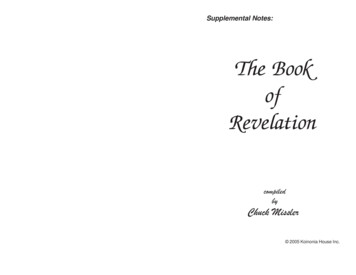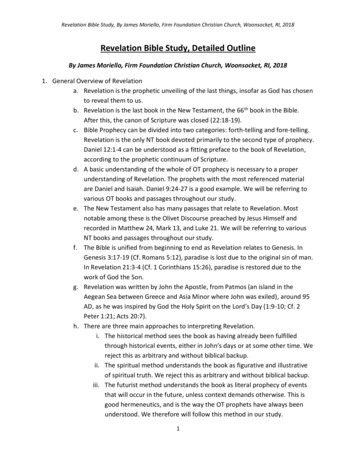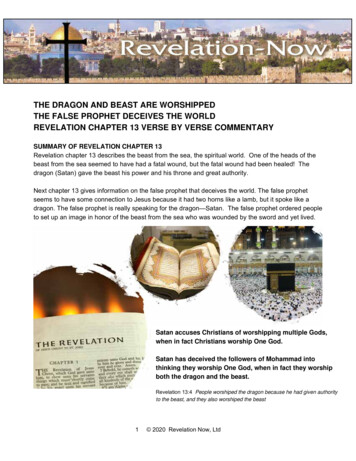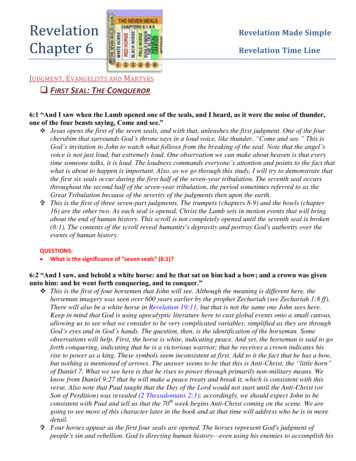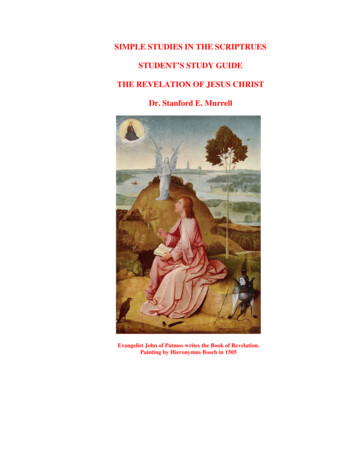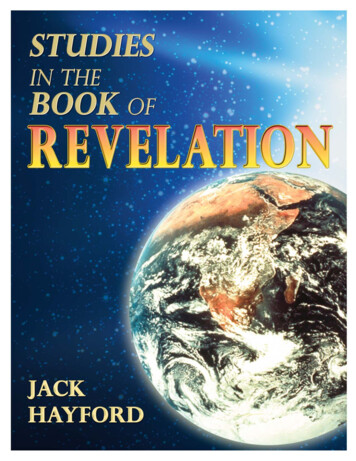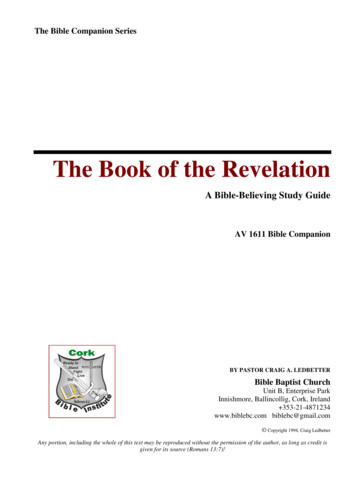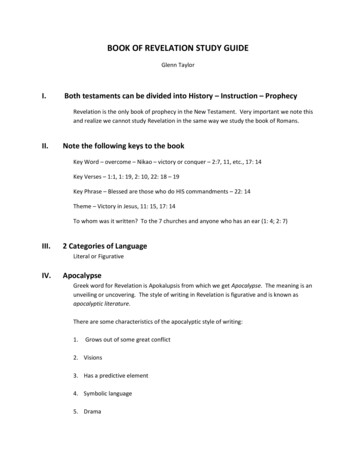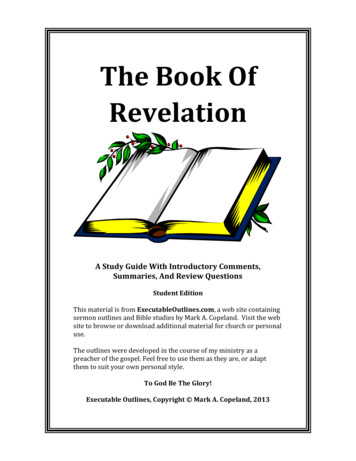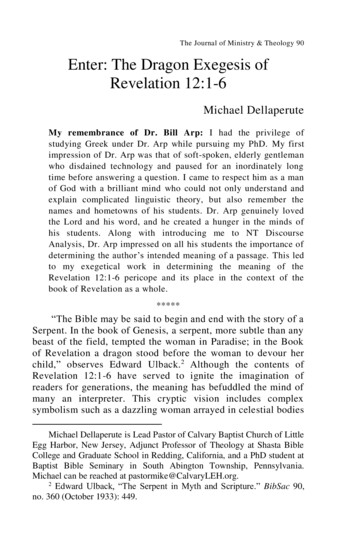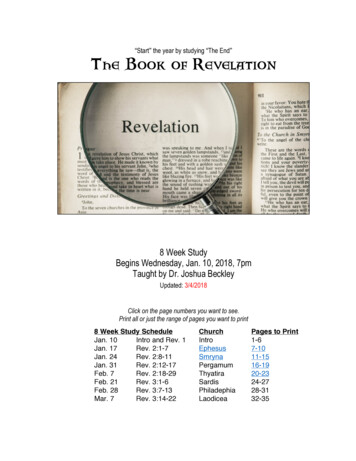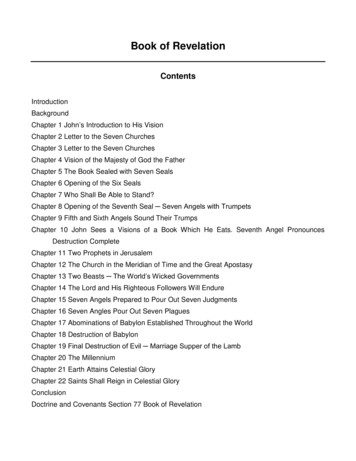
Transcription
Book of RevelationContentsIntroductionBackgroundChapter 1 John’s Introduction to His VisionChapter 2 Letter to the Seven ChurchesChapter 3 Letter to the Seven ChurchesChapter 4 Vision of the Majesty of God the FatherChapter 5 The Book Sealed with Seven SealsChapter 6 Opening of the Six SealsChapter 7 Who Shall Be Able to Stand?Chapter 8 Opening of the Seventh Seal Seven Angels with TrumpetsChapter 9 Fifth and Sixth Angels Sound Their TrumpsChapter 10 John Sees a Visions of a Book Which He Eats. Seventh Angel PronouncesDestruction CompleteChapter 11 Two Prophets in JerusalemChapter 12 The Church in the Meridian of Time and the Great ApostasyChapter 13 Two Beasts The World’s Wicked GovernmentsChapter 14 The Lord and His Righteous Followers Will EndureChapter 15 Seven Angels Prepared to Pour Out Seven JudgmentsChapter 16 Seven Angles Pour Out Seven PlaguesChapter 17 Abominations of Babylon Established Throughout the WorldChapter 18 Destruction of BabylonChapter 19 Final Destruction of Evil Marriage Supper of the LambChapter 20 The MillenniumChapter 21 Earth Attains Celestial GloryChapter 22 Saints Shall Reign in Celestial GloryConclusionDoctrine and Covenants Section 77 Book of Revelation
IntroductionThe world’s biblical scholars have seemed to be frustrated and confused by the book ofRevelation. This fact notwithstanding, the Prophet Joseph once said: “The book of Revelationis one of the plainest books God ever caused to be written” (TPJS, 290). Obviously, Joseph,through the Spirit, had caught the secret of the book, and he loved it!While even today the book remains difficult to interpret, we in the Church do have aconsiderable advantage over the rest of the world. Modern revelation has given usconsiderable insight into the meaning of the book. This revealed material includes sections 77,88, 130, and 131 of the Doctrine and Covenants, 1 Nephi 14:10-27, Ether 4:16 in the Book ofMormon, Joseph’s inspired revision of the King James Bible, and some sermons of theProphet’s which are recorded in his History of the Church, volume 5, pages 298, 336- 37, 33945 and volume 6, pages 363-67. In addition, we will draw upon the helpful work by Dr. RichardD. Draper, Opening the Seven Seals: The Visions of John the Revelator (Salt Lake City:Deseret Book Co., 1991).Brother Draper introduces his book with a provocative keynote statement:John’s invocation upon all those who receive the revelation is rendered bythe King James translators: “Blessed is he that readeth, and they that hear thewords of this prophecy, and keep those things which are written therein: for thetime is at hand” (Revelation 1:3). The last phrase, “for the time is at hand,” iswhat urges me. The Greek (ho gar kairos eggus) can be translated as the KingJames Version does it, but I fear that with that rendering we are likely tomisunderstand John’s thrust the sense is that time is limited, or that timepresses. This captures the idea of how the inner tempo, the spiritual vigor of theage, will escalate as mankind enters the apocalyptic era. As the earth preparesfor the coming of her Lord, time becomes laden with force, charged with anirresistible destiny. The Greek does not employ the ordinary word for time(chronos) but speaks of the Kairos time that has matured; time that has foundfulfillment.Closely connected with the thought is a phrase repeated three times nearthe end of the book: “Behold, I come quickly” (Revelation 22: 7, 12, cf. 20). TheLord is not telling the early Christians to expect him at any moment. Rather, thephrase characterizes a dynamic quality of time. The Lord is saying that hecomes in the pressing, the urgent time the time bearing within it a measurelessspiritual hastening that moves to crescendo upon a humanity unmoved,unrepentant, and unprepared. One scholar said, “That Christ comes quickly canvery well mean that He comes ‘too quickly’ for an unprepared and sleepinghumanity. That the time is ‘near’ may mean that it is ‘short’; that it is actually tooshort considering the slowness and laziness of human souls” (Emil Bock, The
Apocalypse of Saint John, trans. Alfred Heidenreich, Edinburgh: Floris Books,1951, 17) (Draper, 9).The following notes will hopefully create a background framework that will make yourreading and studying the book of Revelation more fun and meaningful in the future.
BackgroundNumerous prophets have been privileged to see panoramic visions that sweep throughtime, but to John was given the privilege of recording the comprehensive vision of the earthfrom its beginning to its end. Joseph Smith on one occasion stated that John “saw the samethings concerning the last days, which Enoch saw” (TPJS, 84). This statement may allude tothe vision of Enoch recorded in Moses 7:41-67, which says in part, “The Lord showed Enochall things, even unto the end of the world; and he saw the day of the righteous, the hour of theirredemption, and received a fulness of joy” (verse 67).The brother of Jared in the Book of Mormon saw, like John, the entire history of theworld (see Ether 3:25-27). The sacred revelation given to the brother of Jared was not to beshared with a faithless world. The Lord gave him explicit instructions:Behold, thou shalt not suffer these things which ye have seen and heardto go forth unto the world, until the time cometh that I shall glorify my name in theflesh; wherefore, ye shall treasure up the things which ye have seen and heard,and show it to no man. And behold, when ye shall come unto me, ye shall writethem and shall seal them up. . .When the Lord had said these words, he showed unto the brother of Jaredall the inhabitants of the earth which had been, and also all that would be; and hewithheld them not from his sight, even unto the ends of the earth. . . And the Lordsaid unto him: Write these things and seal them up; and I will show them in mineown due time unto the children of men (Ether 3:21-22, 25, 27).Moroni’s translation of the vision of the brother of Jared was preserved as the sealedportion of the plates of Mormon. Joseph Smith was expressly forbidden to translate thissealed portion: “Touch them not in order that ye may translate; for that thing is forbidden you,except by and by it shall be wisdom in God” (Ether 5:1). That vision has remained sealed eversince. However, another saw and recorded the same vision. The sealed portion of the Bookof Mormon “contains the same revelation which was given to John upon the isle of Patmos,”albeit Jared’s brother apparently wrote with a great deal more detail.The unique feature about John’s revelation is that the prophet was commanded not toseal it up. Indeed, John seems to be the only prophet commissioned to publish the vision upto this time. Daniel and Nephi also saw and wrote these things, but, like Jared’s brother, theywere commanded to seal them up that they might later come forth in their purity (see Daniel12:4, 9; 1 Nephi 14:25-26). Nephi was expressly forbidden to write what he saw (1 Nephi14:28).Someday, the Lord has promised, the revelation recorded by the brother of Jared will berevealed. This will be in conjunction with the restoration of the gospel. Until then John’srecord will have to fill the gap. Fortunately, this is far from being a burden. Unto Moroni theLord stated, “And then [when Israel comes to accept the Savior] shall my revelations which Ihave caused to be written by my servant John be unfolded in the eyes of all the people.
Remember, when ye see these things, ye shall know that the time is at hand that they shall bemade manifest in very deed” (Ether 4:16). Reading and understanding Revelation can result ina sensitivity to the latter-day events as they unfold.The Revelation of St. John the Divine or the book of Revelation, as we commonly call it,portrays in a dramatic way the historical struggle between the forces of good (Jesus Christ andhis adherents) and the forces of evil (Satan, the anti-Christ).John’s vision is often called the Apocalypse. This title is derived from the ancient Greekword apokalupt, which means to make bare, unveil, disclose, or uncover. In a religious sense,it carries the idea of disclosing divine secrets and making known holy mysteries. Some havefelt, because of the difficult literary style of the book that much of what is written in the bookseems to cover rather than uncover its meaning. Ancient Greek-speaking Jews and earlyChristians used the word to signify a vision with its interpretation, as opposed to a revelation orprophecy (see Romans 16:25; 2 Corinthians 12:1; Galatians 1:12). Thus, “The Apocalypse” isan appropriate title for John’s revelation.There are at least four schools of thought regarding the way in which the book ought tobe interpreted:1. Preterit Everything in the book is in the past, that is, it took place before the bookwas written.2. Allegorical Everything in the book is simply symbolic – nothing is historical or literalor real.3. Futuristic Everything in the book still lies in the future and has not yet happened.4. Historical Contained in the book is past history, present history (at the time ofJohn), and predictions of future historical events.It would appear that approaching the interpretation of the book from a combination of allfour of these viewpoints is most appropriate.The book is probably the finest example of a special literary form called “apocalypticliterature.” Broadly speaking, this type of literature includes accounts of visions of the heavenlyworld and deals chiefly with the coming Millennium. It is the only example of this type ofliterature in the New Testament, though there are other examples in the Old Testamentincluding the books of Daniel, Joel, Ezekiel, and Zechariah. Even the Book of Mormon getsinto the act with 1 Nephi 8, 11-14.Let us explore some of the characteristics of this special type of literature. It iscomposed of three elements. First, it is nearly always eschatological (literally, the study of lastthings). That is, it focuses on a period of time yet future when God will disrupt the flow ofhistory to bring about the end of wickedness and institute a new order of righteousness andpeace. It is God’s breaking into the flow of history and altering it that distinguishes theapocalyptic panorama from its counterpart, prophecy. Apocalyptic literature ignores, and inthis way, denies, man’s capacity to create a peaceful future by overcoming wickedness.Second, apocalyptic literature is dualistic. That is, apocalyptic reality consists of twoirreducible elements or opposing principles: good and evil. The present age is subject to the
powers of evil. Satan and his hosts reign. But his world will collapse into a new timeless ageof perfect righteousness under the authority of ultimate goodness, the Lord Jesus Christ.Third, a rigid determinism marks the whole. Revelation testifies that all things move inconcert toward a divinely predetermined end. Everything is inevitable; nothing is left tochance. The problem of human agency or free will within the context of God’s omnisciencenever surfaces. But there is a tacit insistence that God’s ultimate victory is worked out withinthe framework of human freedom. Yet apocalyptic writers in general, and John in particular,are very pessimistic about mankind’s being able to combat evil and rise out of the presentwicked world. Though individuals can and will repent, as John insists throughout hisrevelation, the world as a whole will not. Thus, God alone has the power to overcome thepower of Satan and the wickedness that exist in it. Therefore, central to the apocalypticframework is faith in God and in his power to control the future and turn all things to theblessing of the righteous.The main theme of apocalyptic literature is “last things”: the end of the earth, the endstage of the age, the ultimate destruction of evil. Its tone is not “Christian” “turn the othercheek” but rather it is often violent and vindictive. There are “rivers of blood,” and the wickedare destroyed by graphic means such as hail, fire, poisons, vapors, and ugly beasts. Therighteous exult that the wicked are being destroyed, and they even ask to help in thedestruction. Apocalyptic literature is sometimes also called “crisis literature” since it is writtenduring a major crisis among the saints. In the book of Revelation, the Christians are beingseverely persecuted under the Roman Emperor Domitian more about this persecution later.Apocalyptic literature may also be called “detour literature.” Generally, when God’s people areon the earth, their theology has had the general theme: “We are the covenant people, and weare going to prosper and march onward and upward to our exaltation or happy end.” Historyhas frequently come along and smashed this idealistic theology. The Assyrians or Persians orRomans or Missourians, etc., have significantly oppressed the Christians, for example. Acrisis is thus created. At this time of crisis, a prophet comes on the scene and writes this typeof literature and “detours” the people around the crisis. He may say, for example, somethinglike, “We did something wrong, and God is punishing us. But be patient. All of God’s promisesto us will still come to pass, but it will simply take a bit longer than we anticipated.” Apocalypticliterature may also be called “upside down literature.” Here are God’s people, and there arethe enemies of God’s people the tools of the devil. Whether they are Romans or Assyriansor Missourians, they are always smashing God’s people! But in the end, some day, there willbe a reversal, a turning upside down. God’s people will overcome the enemy. Finally, therewill be justice!Most of the world’s Bible scholars do not believe that the book of Revelation was writtenby John the Apostle, especially since his other writings the Gospel of John and the epistlesof John are full of love and sweetness, and the book of Revelation is rather dark and vengefulin its tone. We believe, however, that the book was written by John, the beloved apostle ofJesus, probably about AD 90-95 while he served an eighteen-month sentence as a prisoner on
the Isle of Patmos, off the coast of Ephesus. With Peter and James, he had served in the FirstPresidency of the Church, and he was the last of the ancient apostles to minister among thesaints of his day. After his exile on Patmos, he ministered at Ephesus. The Gospel of Johnand his letters were probably written after his exile, between AD 96 and 100.A feeling for the historical setting at the time of John is vital in order to understand thebook. The Roman Empire was led by Julius Caesar between 40 and 44 BC. Following hisassassination, Rome was ruled by a three-man government consisting of Anthony, Octavius,and Lepidus. Then followed the Roman Emperors, the first of which was Octavius who tookthe title Augustus Caesar. At the time of Christ’s birth, Rome was ruled by this AugustusCaesar who ruled from 27 BC to AD 14. At the time of John, Rome was ruled by its eighthemperor, Domitian, who ruled from AD 81 to 96. Between Augustus and Domitian there weresix other emperors. It might seem unimportant to list these six emperors, but it turns out to bevery important to know something about them. The second emperor of Rome was Tiberius(AD 14-37), then Caligula (AD 37-41), Claudia (AD 41-54), Nero (AD 54-68), Vespasian (AD69-79), and Titus (AD 79-81 only a two-year reign). After the suicide of Nero and before theconfirmation of Vespasian, three military generals vied for control of Rome. Each ruled brieflyin succession. They were Galba (6 months), Otho (4 months), and Vitellius (8 months). Thesemilitary generals were never confirmed as emperors, but each wore the crown of leadership.Each of Rome’s emperors believed that he ruled by divine right that he was in factdivine and should be worshiped by the Roman populace. The emperor most adamant incommanding that all Roman subjects (except Jews whom he realized could never be forced tosubmit) worship him as a god, was Domitian. He allowed each Roman citizen to keep his owngods, but he had to be one of them. In order to enforce this worship of himself, Domitianstrengthened and used the state Church and its imperial Roman “priesthood” vested in Rome’spriests. These same priests became, in effect, the enforcers of Domitian’s heinous religiouspolicy. They were assigned to systematically interview Roman subjects to ensure that eachpaid his worshipful homage to Domitian. Upon satisfactory completion of this interview, thesubject would receive a certified card which he carried on his person and which allowed him todo business to buy and sell. Anyone not holding a card was not only prevented from buyingprovisions and selling their services or wares but also might be harassed by being arrested,killed, imprisoned, or in other ways persecuted.Keep in mind that Domitian was emperor of Rome in John’s day. His religious policy, ofcourse, presented a serious predicament for Christians of the day. John set the precedent forthe Christian world by refusing to worship the emperor, and for his stand was imprisoned onPatmos. He also urged all Christians to do the same to “overcome” or to persist in theirconviction and not pay religious homage to the Emperor Domitian. In order for John to be ableto encourage this open rebellion against the prevailing Roman government and emperor, andto even do it in writing the book of Revelation John had to disguise his references to Romeand to the Emperor Domitian lest he be found guilty of treason. In disguising these referencesin the book, he had to do it in such a way that Christians might understand his references and
allusions. He thus refers to Rome as the “beast with seven heads” (the seven emperorsexcluding Domitian) and “ten crowns” (the seven emperors plus the three non-emperor militaryleaders).In order to refer to Domitian himself, he used a clever ploy. To understand this ploy onemust understand the legend of Nero redivivus. Following the suicide of the maniacal EmperorNero in AD 68, a tradition grew among Roman subjects that the wicked Nero was not reallydead – that he was simply hiding somewhere, and he would some day return to resume histyrannical rule. Interestingly, we in this country did the same thing in a more modern day. Atthe death of Adolph Hitler, the story developed that he hadn’t really committed suicide, butrather that his suicide was faked, and he really was alive and living in South America.Apparently, we as humans have a reluctance to let infamously wicked men die. This traditionin Rome grew into a legend or myth and was promulgated in the art and literature of the day.The myth came to be known as Nero redivivus. It wasn’t really believed by intelligent,knowledgeable people, but all knew the story. An analogy in our time might be the story ofSnow White and the Seven Dwarfs. We all know the story though we also know it is notliterally true. The legend of Nero redivivus gave John the opportunity to disguise hisreferences to Domitian. In the book of Revelation, he refers to Domitian as the revived or“resurrected” Nero. Neither John nor any of the Christians believed the legend of Neroredivivus, but the myth gave the Christians a way of referring to Domitian without his orRome’s knowing it.Keep in mind that at the time of John there was no New Testament. The Christians’scripture was the Old Testament. The Christians had an intimate knowledge of the OldTestament almost every phrase. The Romans did not know the Bible. Thus, John could usethe concepts in the Bible to communicate meaningfully with the Christians and still hide hismeaning from the Romans. And use it he did! There are some 400 allusions to OldTestament passages in the book of Revelation. There are 258 direct quotations from the OldTestament in the book.Near Eastern literature, not just Hebrew, reveals a fondness for using numbers tocommunicate ideas. This practice is referred as “numerology.” Why certain numbers becameladen with symbolic meaning is unknown. In most cases this arose in prehistoric times and isnow lost to us. Interestingly there is a general consistency across cultures to the meaning ofcertain numbers. That is not to say that numbers are never used as numbers. However, incertain contexts they express ideas. This is the case in the book of Revelation. One shouldinterpret numbers just as the other symbolic representations. Fortunately, they are usedconsistently. For example, the number “7" meant “totality,” “perfection,” or “wholeness.” Godcreated the world in seven days, and when he finished it was complete. It took seven days tocompletely knock down the walls of Jericho. Seven plagues, seven woes, seven angels,seven thousand years to complete the history of the earth, etc. The number “3" wasrepresentative of government three in the godhood. The number “777" thus combines themeanings of “3" and “7" the ultimate in organizational perfection. The number “4" refers to
things of heaven. The number “6" is “human,” “ordinary,” or “common.” The ultimate humanfrailty is “666.” In addition to the special meaning assigned to each number, there was anumber assigned to each letter of the alphabet used at the time. Thus, a word or name couldbe assigned a numerical value by adding up the numbers assigned to each letter. The name“Jesus” so calculated is “888" which is even greater than the ultimate in perfection “777.”Brother Richard D. Draper has offered another possible explanation as to why the bookof Revelation was recorded in code:There was . . . a problem with recording that information. Both John andNephi seemed to have been aware of it, but Nephi articulated it, stating that theBible would go through the hands of the “great and abominable church, which ismost abominable above all other churches; for behold, they have taken awayfrom the gospel of the Lamb many parts which are plain and most precious; andalso, many covenants of the Lord have they taken away” (1 Nephi 13:26). Thiswas done in a deliberate attempt to pervert the gospel and lead men astray (see1 Nephi 13:14-28). The problem was to get the message through the editors ofthe great and abominable church.John did not choose the form of the vision; God did. The form is nowcalled apocalyptic. It provided John with the means of being able to write in akind of divine code. And it seems to have worked well for him. (Opening theSeven Seals: The Visions of John the Revelator, Salt Lake City: Deseret BookCo., 1991, 14).To his disciples, Jesus said, “Verily I say unto you, There be some standing here, whichshall not taste of death, till they see the Son of man coming in his kingdom” (Matthew 16:28).One wonders if the Lord’s gaze fell upon John. Not many months later, the Savior said to him,“John, my beloved, what desirest thou? For if you shall ask what you will, it shall be grantedunto you” (D&C 7:1). Standing before the Lord of life, John asked what would otherwise havebeen the inconceivable: “Lord, give unto me power over death, that I may live and bring soulsunto thee” (D&C 7: 2). His desire was granted. “Because thou desirest this,” affirmed theLord, “thou shalt tarry until I come in my glory, and shalt prophesy before nations, kindreds,tongues and people” (D&C 7: 3).John’s aspiration set on course the fulfillment of a prophecy made nearly six hundredyears earlier. The American prophet Nephi, caught away in vision, saw the entire history of theworld. Like others, he was forbidden to write but not without explanation:The angel spake unto me, saying: Look! And I looked and beheld a man,and he was dressed in a white robe. And the angel said unto me: Behold one ofthe twelve apostles of the Lamb. Behold, he shall see and write the remainder ofthese things; yea, and also many things which have been. And he shall alsowrite concerning the end of the world.Wherefore, the things which he shall write are just and true; and beholdthey are written in the book which thou beheld proceeding out of the mouth of the
Jew; and at the time they proceeded out of the mouth of the Jew, or, at the timethe book proceeded out of the mouth of the Jew, the things which were writtenwere plain and pure, and most precious and easy to the understanding of allmen.And behold, the things which this apostle of the Lamb shall write are manythings which thou hast seen; and behold, the remainder shalt thou see. But thethings which thou shalt see hereafter thou shalt not write; for the Lord God hathordained the apostle of the Lamb of God that he should write them.And also, others who have been, to them hath he shown all things, andthey have written them; and they are sealed up to come forth in their purity,according to the truth which is in the Lamb, in the own due time of the Lord, untothe house of Israel.And I, Nephi, heard and bear record, that the name of the apostle of theLamb was John, according to the word of the angel (1 Nephi 14:18-27).Thus, it fell to John to give the vision to the world. But as he did so, he also chronicledthe history through which he himself would live. He knew in broad terms the entire history ofthe last two millennia. It is unlikely, however, that he knew of the spiritual manifestation thatawaited him after a Roman ruler, probably Domitian himself, banished him for some time to alittle Greek island in the Aegean Sea.Patmos is a small, roughly butterfly-shaped volcanic island southwest of the Turkish cityof Ephesus. It measures about ten by five miles. Under Rome a number of islands were usedas penal settlements. In addition to Patmos, there were Pontia, off the coast of Latium, andGyara and Seriphus in the Aegean Sea. At that time, Patmos was fertile though it reliedheavily upon rain for its water supply. The prisoners were thus able to take care ofthemselves. Today, though no longer fertile, the island boasts a population of about 2,400fishing families.The revelation came while John was serving time in that penal colony. The exactnature of his punishment is unknown, but it consisted at least in part of banishment. Amongthe Romans there were two types of exile: deportatio and relegatio. Deportatio waspermanent and consisted of the loss of rights and property. Only the emperor could impose it.Relegatio ran in length from one-half to ten years and involved no loss of rights or property.The Roman senate, a city prefect, or other officials could inflict it. John seems to havesuffered the milder relegatio, probably imposed by a governor of the Roman province of Asia ifnot by the emperor himself. At any rate, he was later freed and able to continue his work.Establishing a firm date for John’s imprisonment is impossible. According to histestimony, it was at a time when the Christians were being persecuted on a fairly large scale.Since some forms of harassment were going on from the mid-40s AD and continued off and onthroughout the first and later centuries after the birth of the Lord, no period is totally exempt.Two times vie for the most support among scholars as the period of greatest persecution: thelate-60s AD and the 90s AD. During the former, Nero launched his persecution against the
Christians at Rome. During the latter, Domitian pushed his empire-wide pogrom (an organizedmassacre) of all Christians.Those who favor the Neronian era use evidence from Revelation itself. For example,they point to the head of the beast that was wounded and came alive (see Revelation 13:3) asa reference to Nero. Because this fits certain legends that sprung up shortly after the death ofthe emperor, they insist that John had him in mind. Those who favor Domitian’s time basetheir evidence on the early sources, which are quite unanimous on the subject. In this case, itis the name of Domitian whose name is hidden by the ploy of Nero redivivus. The decade ofthe 90s AD also best fits the evidence.During this decade, the triangular struggle between pagans, Jews, and Christiansescalated in Asia Minor. This was an area that had a tradition for religious strife often sparkedby the frequent natural disasters. About AD 92 there was an anti-Christian outbreak due inpart to a serious famine blamed on the saints because they refused to pay homage to pagangods.Boycotts and trade sanctions were directed against the churches.Arrests,imprisonments, banishments, and even executions followed. The famine first affected PisidianAntioch and later Prusa in the north of the province. Apparently, even areas outside thisprovince were hit.In addition, the emperor Domitian launched a wide pogrom specifically against theChristians. He had a profound hostility toward any form of religious unorthodoxy, that is, anyreligion he felt was antithetical to Roman belief. Prominent citizens who lapsed too blatantlyinto an “external religion” such as Christianity or Judaism came under his censure even to thepoint of banishment and death. Further, he became megalomaniacal late in his career,eventually persuading himself he was lord and god. He demanded that his court address himas such. He ordered libations to be made and incense to be offered before his statues. Thosewho refused, many Christians included, were punished.Under these or similar circumstances John received a sentence of banishment to theisland. There he remained probably for years. At what point he received the apocalypse isunknown, but one may rest assured that this was not the only time John enjoyed comfort fromthe Spirit during his long vigil “for the testimony of Jesus.” Finally, the day came for hisrelease. According to one tradition, he retired to western Asia Minor (present-day Turkey) andthere continued the work of the ministry.What was John’s purpose in writing the book of Revelation? It was at least in part tofulfill the commandment given him directly by Jesus Christ himself (see Revelation 1:11).However, there were at least two other factors at play. Many of the saints were discouraged,even frightened. They were in the midst of the greate
2. Allegorical Everything in the book is simply symbolic -nothing is historical or literal or real. 3. Futuristic Everything in the book still lies in the future and has not yet happened. 4. Historical Contained in the book is past history, present history (at the time of John), and predictions of future historical events.
